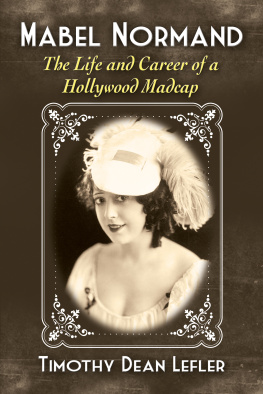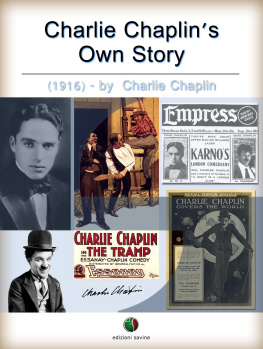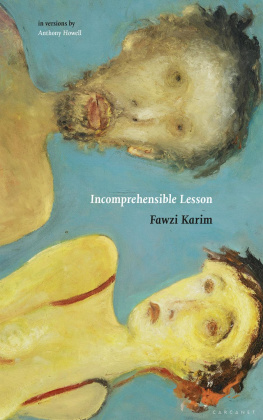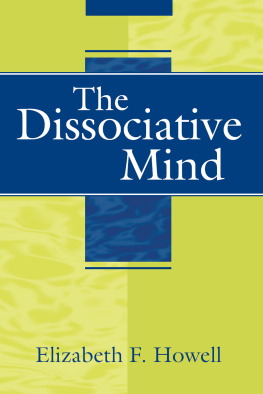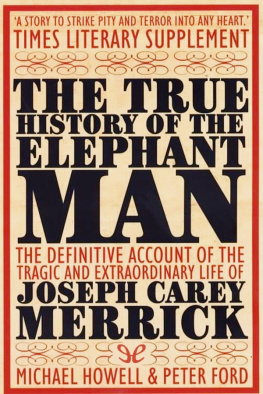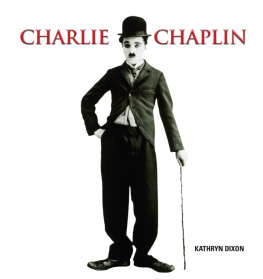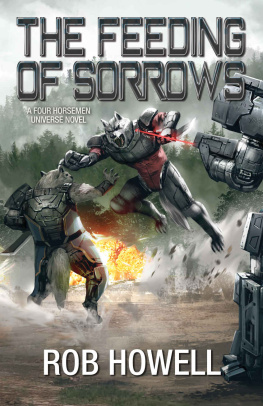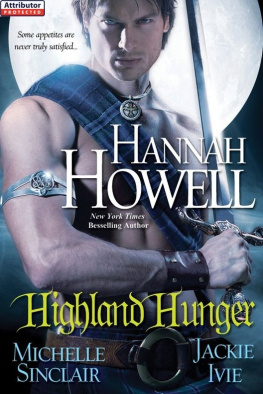
SHE COULD BE CHAPLIN!
HOLLYWOOD LEGENDS SERIES
CARL ROLLYSON, GENERAL EDITOR
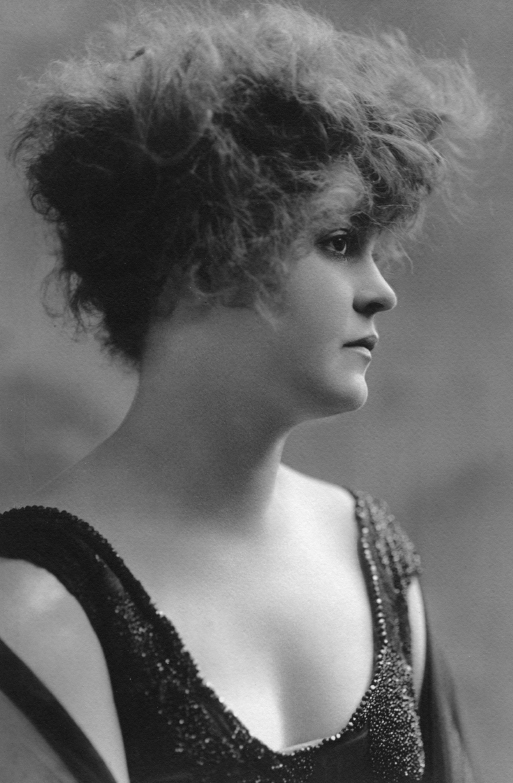
SHE COULD BE CHAPLIN!
THE COMEDIC BRILLIANCE OF
Alice
Howell
ANTHONY SLIDE
UNIVERSITY PRESS OF MISSISSIPPI JACKSON
www.upress.state.ms.us
Designed by Peter D. Halverson
The University Press of Mississippi is a member of the Association
of American University Presses.
Copyright 2016 by University Press of Mississippi
All rights reserved
Manufactured in the United States of America
First printing 2016
Library of Congress Cataloging-in-Publication Data
Names: Slide, Anthony, author.
Title: She could be Chaplin! : the comedic brilliance of Alice Howell / Anthony Slide.
Description: Jackson : University Press of Mississippi, 2016. | Series: Hollywood legends series | Includes bibliographical references and index. | Includes filmography.
Identifiers: LCCN 2016003062 | ISBN 9781496806321 (hardcover : alk. paper)
Subjects: LCSH: Howell, Alice, 1961. | ActorsUnited StatesBiography.
Classification: LCC PN2287.H7315 S57 2016 | DDC 791.4302/8092dc23
LC record available at http://lccn.loc.gov/2016003062
British Library Cataloging-in-Publication Data available
CONTENTS
ACKNOWLEDGMENTS
FIRST AND FOREMOST, I MUST THANK GEORGE STEVENS JR. NOT ONLY for writing a foreword to this monograph, but also for commissioning an earlier version many years ago. He has been unfailing and unstinting in his encouragement and support for this first major, and hopefully definitive, study of the life and career of his grandmother, Alice Howell. Thanks must also go to Georges son, Michael Stevens, who was present at the second of my interviews with his grandmother, Yvonne Stevens, and also provided me with access to family papers and photographs. I could not have written a study such as this without the help of Alice Howells daughter, the late Yvonne Stevens, whom I had the pleasure first to meet so many decades ago, back in the early 1970s. And, of course, no reference to George Stevens Jr. would be complete without recognition of his secretary, Dottie McCarthy.
Primary research was undertaken at the Margaret Herrick Library of the Academy of Motion Picture Arts and Sciences, with additional help and support provided by Tjitte de Vries, Sam Gill, Robert Gitt, and Patricia King Hanson. Diana Serra Cary (Baby Peggy) was, as always, willing to answer any questions I might have, although, regretfully, she had no remembrance of Alice Howell. Also supportive were Mike Mashon at the Library of Congress, Marion Meade, and Carl Rollyson.
At the University Press of Mississippi, I am grateful again to Leila Salisbury, who has never failed to encourage me and provide an outlet for my sometimes egocentric writings and research, even if I do occasionally decide to publish a book elsewhere. Also at Mississippi, I must thank Valerie Jones and designer Pete Halverson, as well as copy editor Peter Tonguette.
Finally, a special thank you to Managing Editor Anne Stascavage, who is retiring after seeing this book through to production. She will be missed.
Photographs were provided by George Stevens Jr. and the Stevens Family Archive, the Academy of Motion Picture Arts and Sciences, or originate from the authors collection.
FOREWORD
THE ERA OF SILENT FILM IN AMERICA WAS A BREATHTAKINGLY RICH period of creativity, where pioneer artists were exploiting a new medium for which there were no models or precedents. This epoch presents a daunting challenge to historians because it is so difficult to locate and view the films of the 1910s and 1920s. Finding these early works is Americas version of the search in the Holy Land for the Dead Sea Scrolls.
When we started the American Film Institute in 1967 we learned that more than half of the films made up to that time were lost or missing or in danger of being destroyed. This was the result of neglect by the producing entities that turned out thousands of silent films with little concern for preservation and record-keeping, and because the nitrate motion picture stock used in their time was volatile, often turning to jelly in its containers, and was vulnerable to destructive fires.
I have great admiration for the dedicated historians of the silent era because of their persistence in seeking out difficult to find motion pictures, and for the priceless perspective they provide on this art that was developed to such a large extent in the United States.
Tony Slide is a pioneer film historian who has dedicated himself to the study of the silent era, dating back to the early 1960s when he became enchanted with film as a young man in his native England. I met him when he came to the United States in 1971 to work on the film rescue and cataloging efforts of the American Film Institute, and in ensuing years he has published more than seventy valuable works on motion picture history. He is considered a leading authority on the silent era.
Alice Howell had an extraordinary career as a film comedienne, and were it not for Anthony Slide and other industrious historians, her work would have been altogether forgotten. Slide first saw Alice on the screen in England in a 1920 short called A Mere Mans Love. He found her enchanting, and over the years he pursued every opportunity to see and write about the Howell films that survive from among the more than a hundred she starred in.
Alice started out at the Mack Sennett studios in 1913 and appeared in the first six films that Chaplin directed. She went on to have a career as a leading comedienne, modeling aspects of her characters on what she learned from Chaplin.
Tony Slide sought me out when he was working at the American Film Institute to tell me of his admiration and interest in Alice Howell, whom he knew to be my maternal grandmother. He was eager to know more about her and I arranged for him to interview her daughter, my mother, Yvonne Stevens, who grew up in Hollywood and had the greatest body of first hand knowledge about Alices life and career. Tony includes those interviews in this book.
Now Tony Slide is telling the story of Alice Howell, adding a rich new chapter to the history of American motion pictures. Whereas in the past it was next to impossible to see Alices screen performances, we hope that as a result of contemporary preservation efforts, and accessibility through new media, her surviving films will be increasingly available to interested fans and film scholars.
To me Alice Howell was simply the nice lady who happened to be my grandmother, who lived across the courtyard from us when I was young. Now, in these pages we can come to know her as a talented movie pioneer who lived a fascinating creative life in early Hollywood.
George Stevens Jr.
SHE COULD BE CHAPLIN!

Mabel Normand.
Introduction
THE WORLD OF SILENT COMEDY IS DOMINATED BY THE NAMES OF famous menChaplin, Keaton, Lloyd, and otherswith women generally relegated to the ranks of leading ladies, in reality little more than supporting players. If any female comedy performer from the silent era has instant name recognition it is Mabel Normand (18921930), not because she was one of Mack Sennetts stars prior to Chaplin or because she directed some of his earliest short subjects, but because she was the comedians leading lady and went on to enjoy a starring career in her own right. (The fight against drug addiction certainly did not hurt her modern fame, even if it did have a devastating effect on her career, leading to an early death.) Yet there is another female comedy star, with a unique and original style, who also began her career with Mack Sennett and was also there as a female support in the first film Chaplin both wrote and directed,
Next page

